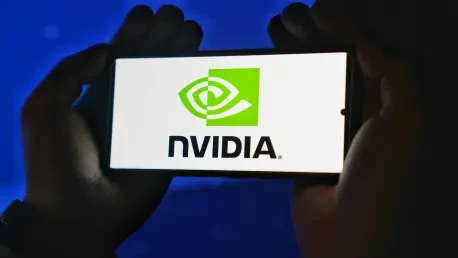In the fast-evolving landscape of technology, Nvidia stands as a titan in the semiconductor industry, renowned for its groundbreaking graphical processing units (GPUs) that power gaming and artificial intelligence (AI) applications. Yet, the company’s latest endeavor into the Artificial Intelligence Radio Access Network (AI-RAN) market—a specialized segment of the telecom industry that integrates AI with radio access network technologies—has sparked both intrigue and skepticism. This strategic pivot aims to diversify Nvidia’s revenue, which is heavily concentrated among a handful of major clients like Microsoft and Meta. However, with the RAN market generating a modest $35 billion annually compared to Nvidia’s quarterly gross profit of $34 billion, doubts linger about whether this niche can deliver meaningful growth. As Nvidia pushes to position telecom operators as alternative data center providers, particularly in regions concerned about US cloud dependency, the question remains: is this bold move gaining traction, or is it faltering amid financial, technical, and competitive challenges? This exploration delves into the motivations behind Nvidia’s AI-RAN push, the geopolitical trends shaping its path, and the significant hurdles that could impede its success in the telecom arena.
Strategic Ambitions and Market Fit
Nvidia’s foray into AI-RAN represents a calculated effort to expand beyond its traditional strongholds in AI and gaming, targeting a market that, while small, holds potential for diversification. The underlying motivation appears to be a response to the company’s revenue concentration risk, with 30% of its income derived from just two hyperscaler clients. By tapping into the telecom sector, Nvidia envisions operators as substitutes for US-based cloud giants in regions prioritizing data sovereignty. The AI-RAN concept leverages Nvidia’s GPUs for both traditional RAN signal processing and hosting AI applications outside dominant US public clouds, potentially redefining telcos’ role in the data center landscape. Yet, the modest scale of the RAN market raises questions about whether this venture can significantly impact Nvidia’s financial trajectory. Industry observers note a disconnect between Nvidia’s core expertise and the specialized demands of telecom infrastructure, suggesting that this pivot might stretch the company’s capabilities in unfamiliar territory.
Beyond the strategic mismatch, the financial realities of the telecom industry present a formidable barrier. Telcos, unlike hyperscalers, operate with constrained budgets for capital expenditure. For instance, a major player like T-Mobile US allocated just $8.84 billion in 2024, a stark contrast to Microsoft’s $64.6 billion in the same period. European operators, often grappling with fragmented markets and intense competition, frequently prioritize cost reduction over ambitious infrastructure projects. This financial disparity casts serious doubt on whether telcos can justify the substantial investments required to adopt Nvidia’s AI-RAN solutions at a scale that would benefit the semiconductor giant. Without significant buy-in from these potential customers, Nvidia’s vision of transforming telecom operators into viable data center alternatives risks remaining a theoretical proposition rather than a practical reality.
Geopolitical Dynamics and Sovereignty Dilemmas
Geopolitical currents play a pivotal role in shaping Nvidia’s AI-RAN strategy, particularly with the rising emphasis on “sovereign AI” and “sovereign cloud” in regions like Europe. Companies such as Deutsche Telekom are investing in localized data centers equipped with Nvidia GPUs, driven by concerns over US technological dominance and the need to protect data privacy. This trend aligns with Nvidia’s goal of penetrating non-US markets, offering a potential foothold where distrust of American cloud providers runs deep. However, the notion of achieving true sovereignty with US-made technology sparks skepticism among analysts. The inclusion of components from controversial vendors like Huawei in some of these setups further complicates the narrative, undermining claims of independence and raising questions about the authenticity of such initiatives.
Adding to the geopolitical complexity, political rhetoric from influential figures like Donald Trump, who has criticized foreign digital regulations, may inadvertently accelerate regions’ push for technological autonomy. This dynamic could bolster Nvidia’s appeal in markets seeking alternatives to US hyperscalers, yet it also highlights a fundamental paradox. If data centers rely on American GPUs, can they genuinely be considered sovereign? This tension risks alienating potential customers who prioritize complete independence from foreign tech influence. For Nvidia, navigating this delicate balance between opportunity and contradiction will be crucial, as regional policies and perceptions could either propel or hinder its ambitions in the telecom sector, depending on how these sovereignty debates evolve.
Technical Hurdles and Industry Readiness
On the technological front, integrating Nvidia’s GPUs into RAN infrastructure poses significant challenges that could stall widespread adoption. RAN chips are typically deployed at mast sites or centralized facilities connected by fiber, whereas GPU-as-a-service operates from large, regional data centers. This geographical disparity creates latency issues for AI applications, which often demand real-time processing. Addressing this might require a proliferation of “edge” data centers closer to end users—a demand that, at present, lacks clear market justification. Nvidia’s Aerial software suite, touted for enhancing spectral efficiency through AI-driven signal processing, aims to bridge some of these gaps. However, doubts persist about its readiness for broad deployment, with competitors questioning whether it offers tangible advantages over established solutions.
Further complicating matters, industry giants like Qualcomm and Ericsson express reservations about the practical benefits of Nvidia’s approach. Existing custom silicon and CPUs have been refined over decades to meet RAN requirements, often incorporating AI capabilities without the need for GPU-specific architectures. Transitioning to Nvidia’s CUDA platform would demand substantial software redevelopment, a costly and time-intensive process for telecom vendors already satisfied with current technologies. Until a compelling, AI-driven use case emerges that justifies such a shift—beyond basic RAN compute functions—Nvidia may struggle to convince the industry of the necessity of its solutions. These technical and readiness concerns underscore the uphill battle in aligning GPU strengths with the unique needs of telecom infrastructure.
Competitive Resistance and Market Reception
The telecom industry’s response to Nvidia’s AI-RAN initiative has been notably tepid, with major RAN vendors showing reluctance to embrace GPU-based solutions. Companies like Ericsson and Nokia, key players in the sector, prioritize hardware independence through virtualization, favoring CPUs or custom chips over Nvidia’s offerings. The effort required to rewrite software for the CUDA architecture is viewed as a significant deterrent, especially without a clear, transformative AI application to justify the investment. This hesitation from industry heavyweights signals a broader lack of enthusiasm, slowing Nvidia’s momentum and casting doubt on the feasibility of gaining a substantial foothold in this market.
Compounding the challenge, Nvidia faces restricted access to critical segments of the RAN market due to US sanctions on entities like Huawei, a major global player. This limitation narrows the company’s potential customer base, hindering its ability to scale AI-RAN adoption. Meanwhile, cloud market data reveals the overwhelming dominance of hyperscalers like AWS and Microsoft, which command a 63% share, while telcos outside China barely register as significant contenders. This disparity highlights the difficulty of positioning telecom operators as credible alternatives to established cloud providers. Without broader industry buy-in or a shift in competitive dynamics, Nvidia’s vision for AI-RAN risks remaining a niche experiment rather than a transformative force in telecom.
Global Traction and Future Prospects
Evidence of widespread adoption of Nvidia’s AI-RAN technology remains scarce, despite the company’s assertions of interest from “sovereign” and “neo” cloud initiatives. Isolated partnerships, such as with Japan’s SoftBank, stand out as notable but rare successes in an otherwise unenthusiastic global landscape. Most telecom operators lack the financial resources and strategic focus to compete with hyperscalers in cloud and AI infrastructure, leaving Nvidia’s aspiration of redefining telcos as data center providers largely unfulfilled. Revenue data further illustrates this challenge, with Nvidia’s earnings heavily concentrated in key billing locations like the US and Taiwan, while contributions from other regions remain minimal, reflecting limited international traction for AI-RAN.
Looking ahead, the trend of data sovereignty offers a potential long-term opportunity for Nvidia to carve out a space in the telecom market. If geopolitical tensions and regulatory pressures continue to drive demand for localized technology solutions, the company could find receptive audiences in regions prioritizing independence. However, overcoming the current financial, technical, and competitive barriers will require tailored innovations and strategic partnerships that address the unique constraints of telcos. Reflecting on the journey so far, Nvidia’s bold push into AI-RAN has faced significant resistance from an industry entrenched in existing technologies and skeptical of unproven benefits. The path forward hinges on demonstrating undeniable value through AI-driven use cases and adapting to the nuanced needs of global markets, ensuring that past stumbles inform future strides.









